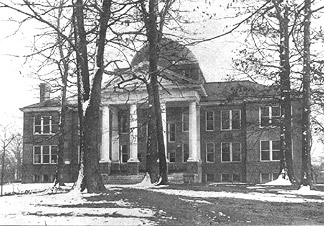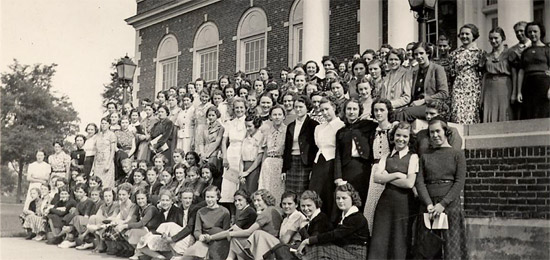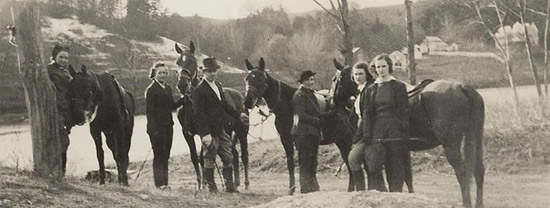Our History

The institution now known as Radford University was founded by the Virginia General Assembly in the spring of 1910. The State Normal and Industrial School for Women at Radford grew out of a late nineteenth-century effort to expand Virginia's public school system and prepare a sufficient number of teachers. The school was to be located on 33 acres in east Radford known as the "Heth Grove." On October 3, 1911, Dr. John Preston McConnell was appointed president of the institution.
The first building on Radford's campus was started in 1911, and a crew of 50 men took 14 months to complete it. Founder's Hall, with its copper dome and ornate features, was one of the most notable structures between Roanoke and Bristol. The building housed administrative offices, a gymnasium, auditorium, library, and classrooms and was dedicated on August 9, 1913, just before the September 17 start of the school's first session.
The students who arrived that fall had several options. Those who had come from two- and three-year high schools could complete their high school degree and earn up to a two-year Normal School Diploma. Students who had graduated from a four-year high school could choose to pursue an "industrial" degree in the rural arts, household arts, and manual arts. Courses were designed to give students a well-rounded, teaching-focused education.
With no dormitories, the school rented two nearby buildings for student housing, Heth House and La Belle Inn. Life on campus was very strict and required the ladies to be "Southern Gentlewomen," observing Victorian values and prudence.
Dr. McConnell selected the school creed from an 1852 Daniel Webster quotation:
"If we work upon marble, it will perish.
If we work upon brass, time will efface it.
If we rear temples, they will crumble to dust.
But if we work upon men's immortal minds,
if we imbue them with high principles,
With the just fear of God and love of their fellowmen,
we engrave on those tablets
something which no time can efface,
and which will brighten and brighten to all eternity."
The school colors of purple and gray were chosen, a chapter of the Young Women's Christian Association (YWCA) was established, and an Alma Mater was written in 1913. The Student Government Association was established in 1914 and adopted the Honor System in 1917.
Alma Mater
Hail all Hail! To our Alma Mater
Bare our heads, make the welkin ring;
Hers our hearts and our fond allegiance
Honors to her we bring.
Praise her broad and lofty aim,
Her purpose ne'er will fail;
Hail to thee, our Alma Mater,
Hail, all Hail!
Hail, all Hail! To the Radford Normal
Give three cheers, and then one cheer more;
Let the praise of our Alma Mater
Echo from shore to shore;
She is ours and our loyalty
will never, never fail.
Hail to thee our Alma Mater,
Hail, all Hail!
Radford's campus continued to grow in the late teens and early '20s. Tyler Hall, the school's first official residence hall, was built in three sections: the first opened in 1915, the second in 1916, and the third was completed in 1923. The Radnor, the school's first annual, was published from 1914-1917 and discontinued due to World War I. The successor to the Radnor, renamed the Beehive after the school seal, was first published in 1924. The Grapurchat, the first student newspaper, began in 1921.
Radford State Teachers College

In 1924, the school's name was changed to State Teachers College. For several years the curriculum had been undergoing revisions, high school courses had been dropped and the state had mandated that Radford focus on preparing teachers for rural school systems. While observing state guidelines, Dr. McConnell insisted that "good teaching required good courses whether it prepares teachers for rural or city schools." His dedication to equal opportunity for Radford's students continued throughout his presidency. Radford's first Bachelor of Science degrees had been awarded in 1921. The student teaching program had been expanded outside the city of Radford to the surrounding counties and towns. In 1928, Radford built its own training school, McGuffey Hall, now known as Whitt Hall.
The first sorority chapter was established at Radford in 1929. Sigma Sigma Sigma (Tri Sigma) was founded with 25 students and heralded the beginning of a new social era of sororities and societies at Radford. The strong traditions of the Ingles and Pocahontas Societies were bid farewell as the main campus organizations.
The May Day celebration, which had long been a popular spring athletic program, became more elaborate and formal in the mid '30s. The crowning of a May Queen became the major campus social activity of the year. During the mid- and late-1930s, Radford's dedication to the advancement of education in Virginia continued with participation in the "Virginia New Curriculum." Progressive educational ideas and programs were instituted at the McGuffey training school, bringing teachers, supervisors, and education officials from across the state to Radford. The hope was to continue to enhance Radford's reputation as an excellent teaching facility in Virginia.
On November 15, 1937, Dr. McConnell resigned his position as president due to ill health. Mr. Jeremy Pate Whitt, the school's registrar, was named acting president until a successor could be chosen. Dr. David W. Peters assumed the role of president of Radford College on January 1, 1938.
Radford had come through the Depression relatively unscathed. In fact, several new initiatives had begun including the construction of McConnell Library, expansion of the stone wall which surrounded the campus, and the reconstruction of a log house, originally the birthplace of Mr. Whitt, which was to serve as a museum during its 20-year existence.

Many federal programs designed to improve the economy benefitted the Radford campus during the 1930s. Improvements were made to existing buildings and a dining hall was built in an area that was originally designated for Ingles and Pocahontas Society Homes. The annual was discontinued due to funding difficulties in 1930, but launched again in 1937.
War and Marriage
Dr. McConnell passed away on October 13, 1941, signaling the end of an era at Radford. The coming year brought World War II and caused disruptions on the campus with many of the faculty serving in the armed forces. A War Defense Council was organized in 1942 and campus programs were coordinated with the city. Classes were modified to focus on the war, including courses such as Geography for the War, War Craft Math, and Pre-Flight Aeronautics.
As the war progressed, Radford continued to survive through enrollment drops and further changes. In 1943 a merger was proposed between Radford and nearby Virginia Polytechnic Institute as part of a statewide effort to consolidate higher education institutions and give students the most adequate opportunity for a broad professional and technical education. As the Women's Division of V.P.I., Radford students would have the opportunity to pursue the same programs available to men and duplicate courses were eliminated between the two schools.
Immediately following the war years, enrollment expanded at an amazing rate. Peacetime made money available for new construction and renovation. In 1948, Radford College began to expand outside the stone wall which had surrounded the campus for many years. A new residence hall was completed in 1950, and in 1951 a new McGuffey school was constructed, reflecting modern elementary school design. The 1950s brought many physical changes, but a leadership change also took place when Dr. Peters passed away on August 2, 1951. Once more, Jeremy Whitt was asked to serve as acting president, a position he held until his own death just a few months later.
Dr. Charles Knox Martin, Jr. officially became Radford's third president on January 17, 1952. Under the Martin administration, Radford continued to grow and prosper throughout the 1950s with many additions, including Peters Hall and, after a struggle with the legislature, the construction of Pocahontas Hall.
50 Years and Growing
The 1960s began with a celebration of Radford's first half-century. The school had seen tremendous growth and expansion, three identity changes and three presidents. In 1964, due to the immense progress made at Radford, the "marriage" with V.P.I. was dissolved. Radford was known simply as Radford College and with the autonomy came pressures for change from many external forces. The turbulent 1960s were a strange experience on the Radford campus, partly because of many of the "finishing school" characteristics instituted 50 years earlier.
Students pushed for more and more freedoms at Radford, as they did at schools across the U.S. One by one, many of the traditions which had defined Radford as a "Southern Gentlewoman's" school were abolished. The final major change that brought Radford into the present was the undergraduate admission of men in the summer of 1972.
In 1972, Dr. Martin assumed the position of college chancellor, which had been vacant since the split with V.P.I. Also in 1972, Dr. Donald N. Dedmon took office on March 20, as Radford's fourth president. During Dr. Dedmon's administration, Radford College grew in stature and size to a comprehensive, coeducational institution. In 1979, Radford was granted university status by the General Assembly, resulting in the school's fifth name change. In the 1970s, Radford adopted the nickname "Highlanders" for the athletic teams in celebration of the Scottish heritage of Southwest Virginia. In keeping with the Scottish theme, school colors were changed from purple and gray to the tartan plaid colors of red, white, blue, and green. The school newspaper was renamed The Tartan and the literary magazine adopted the name Gaelic. The annual remained The Beehive.
Growth continued at a rapid pace through the 1980s with more than 9,000 students attending Radford University per year by the end of the decade. The look and size of the campus also continued to evolve with the construction of a state-of-the-art sports complex named for Dr. Dedmon. The Dedmon Center was one of the first buildings designed with an inflated, air-supported roof, similar to that of the domed stadium in Indianapolis. The location of the Dedmon Center was also a change for the campus, as new properties adjacent to the New River were acquired from the railroad.
In June 1994, after 22 years as president, Dr. Dedmon announced his retirement. Vice President for Academic Affairs, Dr. Charles W. Owens, was named acting president until a successor was found. After a national search, Dr. Douglas Covington was named the fifth president and took office in June of 1995. Dr. Covington retired in 2005 and Penelope W. Kyle became the university's sixth president in June 2005. The Galax, Va., native joined Radford University with more than 30 years of experience in Virginia state government, the corporate and legal arenas, and higher education. A graduate of Guilford College, she earned a Juris Doctor degree from the University of Virginia and an MBA from the College of William and Mary.
On July 1, 2016, Dr. Brian O. Hemphill became the seventh president of Radford University.
Into the 21st Century
Radford University continues to cultivate a thriving university community well into the 21st century. In 2008, The Douglas and Beatrice Covington Center for Visual and Performing Arts opened and became one of the most technologically advanced arts facilities and arts education resources in Southwest Virginia. An extraordinary venue that offers patrons throughout the New River Valley concerts, performances and recitals, the Covington Center features a 350-seat performance hall, rehearsal rooms, teaching studios, music media center, and an art gallery.
Following an extensive renovation in 2009, Young Hall provides Radford University students modern, flexible study spaces filled with advanced, high-definition technologies. It has become the go-to spot on campus for students thanks to its late-night and weekend hours.
In the summer of 2011, Radford University granted its first doctoral degrees. The recipients, DeEtta Compton and Faye Lyons, earned their doctorates in nursing practice (DNP) from the School of Nursing, in the Waldron College of Health and Human Services. President Kyle noted in her remarks at a ceremony honoring the two, “You have become a part of Radford’s history. You have led us into the ranks of doctoral universities in the Commonwealth of Virginia and by doing so have helped rewrite the very definition of education at Radford. Along with your colleagues and professors, you have raised the prestige and public profile of Radford University to the advantage of our future students and graduates. For that, we are all deeply grateful.” The DNP promotes the advancement of health care and education in Virginia and beyond.
Also in the summer of 2011, the Doctor of Physical Therapy program welcomed its first students. The program is a collaborative endeavor with Carilion Clinic and the Jefferson College of Health Sciences. This sought-after degree enables Radford University to address a critical need for physical therapists in Southwest and Southside Virginia.
As evidence of Radford University’s continued growth and appeal to prospective students and their families, the largest freshman class in the university’s history was welcomed in the fall of 2012. In the U.S. News and World Report’s 2010 Guide to America’s Best Colleges Radford University is listed as one of the nation’s “Top Up-and-Coming Schools.” In addition, the Princeton Review named Radford University to its list of best colleges and universities in the Southeast for a ninth consecutive year.
Recent Progress
As part of Radford University’s 2010 Centennial activities, the university broke ground for a new home for the College of Business and Economics, later named Kyle Hall. The $44 million complex, which opened in August 2012, features laboratories and classrooms with the latest technological and financial research capabilities for Radford's 1,500 business majors, multipurpose areas available to alumni and the community, and a trading room with running stock quotes and a continual data feed.
Radford University has always been committed to educating the whole student, both inside and outside of the classroom. To that end, 110,000-square-foot recreation and wellness center opened in 2014. The facility provides students with recreational, wellness and exercise therapies.
The Center for the Sciences encompasses the original 1930s-era Georgian building; a modernist 1960s addition; and a $49 million, 115,000-square-foot annex, which opened in January 2016. It includes teaching and research laboratories, the Museum of the Earth Sciences and the Radford University Planetarium.
Following Kyle’s retirement, Brian O. Hemphill, Ph.D., became the seventh president of Radford University on July 1, 2016.
A Look Into the Future
The College of Humanities and Behavioral Sciences opened in Fall 2016. The 143,600 square-foot building is the largest academic building on Radford University’s campus and houses all of the college’s academic units. The state-of-the-art space features a mock trial/moot courtroom, a television studio, a forensic laboratory and an Emergency Management Center. Radford University is a place where students come first. In recent years, significant investments have been made in scholarship support to provide opportunities for current and future generations. In Spring 2017, Radford University announced the naming of the Artis College of Science and Technology due to the generosity of Nancy E. and H. Pat Artis. And, in Fall 2018, Radford University announced the naming of the Davis College of Business and Economics due to the generosity of Sandra C. and William C. Davis.
Radford University has embraced its historical mission of teaching and learning, while, at the same time, looking to the future with a focus on innovation. In Fall 2017, the university launched IMPACT, a competency-based program targeting the adult learner population with a focus on cybersecurity, geospatial intelligence and education. Radford was the first public university in the Commonwealth of Virginia to launch a competency-based education program. The university also secured a $13.8 million grant from the U.S. Department of Education, representing the largest grant in the history of the university, in order to support the IMPACT program. Furthermore, in early 2018, Carilion Clinic, Jefferson College of Health Sciences and Radford University joined together to announce the intent to merge Jefferson College of Health Sciences into the Radford University family of colleges and departments. Following 18 months of collaboration and planning, the merger came to life, as Radford University Carilion, and enrolled the first class of Highlanders in Fall 2019.
In July 2022, the university welcomed its eighth president, Bret Danilowicz, Ph.D. Danilowicz emphasizes the “four P’s” – people, purpose, place, pride – and is committed to both amplifying Radford’s attractions as an education destination and underscoring its importance to the community and region.
For the first time, in 2022, Radford University was categorized by the Carnegie Commission as a doctoral/professional university; between the main campus and RUC, Radford currently offers six doctoral degrees. With its new national profile, the university eagerly faces the challenges and opportunities of the future.